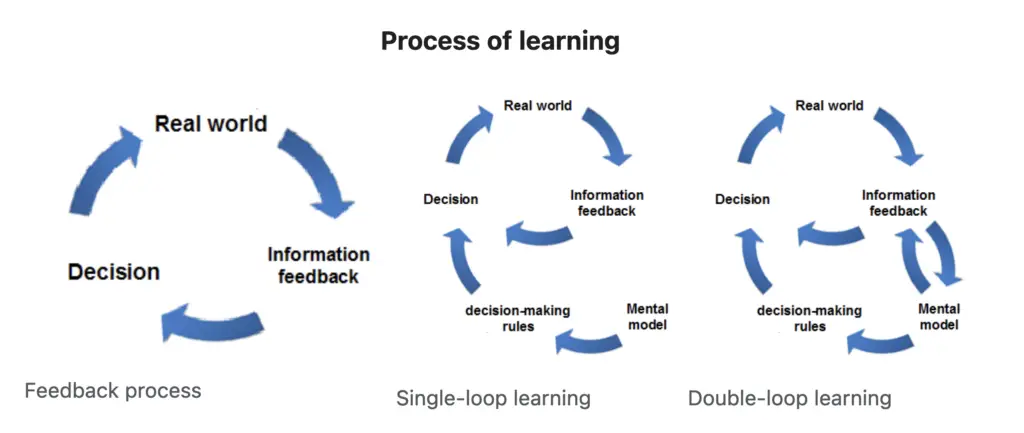Definitions
Strategic Planning: Strategic planning is a systematic, formally documented process for deciding the handful of key decisions that an organization, viewed as a corporate whole, must get right in order to thrive over the next few years. It involves defining the organization’s strategy or direction and making decisions on allocating resources to pursue this strategy, including its capital and people.
Thinking: Thinking is the process of using one’s mind to consider or reason about something. It involves processing information, reasoning, problem-solving, understanding, and making judgments and decisions. Thinking involves concepts including ideation, intellection, and intuition.
Mental Models: Mental models are internal representations of how the world works. They are cognitive frameworks or sets of beliefs and ideas that individuals use to understand and interpret the world around them. Mental models guide perception and behavior, helping people to make decisions and solve problems by simplifying complex situations into more manageable components.
A simple explanation of how Mental Models expand Thinking and Learning

The above figure illustrates how we can use mental models to enhance the quality of our thoughts, our decisions, our learning, and our knowledge.
- “Feedback process” on the left illustrates and absence of rules for making decisions and what many would call learning by hard knocks. [From time to time, we all back into learning from hard knocks.]
- “Single-loop learning” in the centre illustrates the application of mental models which are applied with rules for decision-making. The application of mental models and rules for decision-making improves and we experience far fewer hard knocks. [To various degrees, we all learn how to avoid at least the hardest of knocks.]
- “Double-loop learning” on the right illustrates conscious efforts to understand and apply mental models that have been evaluated and proven to work to remove or significantly reduce the pain of hard knocks. As the second complete loop illustrates, this is an iterative learning process. A very good example of comprehensive double-loop learning is Ray Dalio’s believability-weighted PRINCIPLES [The best decision makers develop and use a set of tools to assist them as continuously improve the way they make business decisions.]
A sampling of Mental Models used in Business Decision-Making
The following are well-known mental models…often referred to as “common sense”.
- SWOT Analysis: A strategic planning tool analyzing Strengths, Weaknesses, Opportunities, and Threats.
- Sunk Cost Fallacy: The tendency to continue an endeavor once an investment in money, effort, or time has been made.
- Pareto Principle (80/20 Rule): States that roughly 80% of effects come from 20% of causes.
- Occam’s Razor: The principle that the simplest explanation is often the most likely.
- Maslow’s Hierarchy of Needs: A pyramid-shaped hierarchy of human needs, from basic (food, shelter) to advanced (self-actualization).
- First Principles Thinking: Breaking down complex problems into basic elements and reassembling them from the ground up.
- Confirmation Bias: The tendency to search for, interpret, and remember information in a way that confirms one’s preconceptions.
Embrace Mental Models and Believability-Weighted Decision-Making
The use of mental models in business decision-making is a critical aspect of strategic thinking and problem-solving. However, in practice, these models are often underutilized or misapplied, leading to less optimal or even flawed decisions. Here are some key reasons why this happens:
- Lack of Awareness: Many business professionals may not be aware of the range of mental models available. Without knowledge of these frameworks, they cannot leverage them in decision-making processes.
- Over-Reliance on a Few Models: Even when mental models are used, there’s a tendency to rely heavily on a few or even a single mental model, like SWOT Analysis. This can lead to a narrow perspective, as different models provide different insights and solutions.
- Confirmation Bias: This is a common mental block in business decision-making. Business leaders often use mental models to validate their pre-existing beliefs or choices, rather than challenging their assumptions or considering alternative viewpoints. This selective use of mental models can reinforce existing biases and lead to poor decision-making.
- Misinterpretation or Misapplication: Even when business leaders are aware of various mental models, they can misinterpret them or apply them incorrectly.
- Complexity and Time Constraints: Business decisions often have to be made quickly and under pressure. In such scenarios, people may think there is not be enough time to thoroughly apply or consider multiple mental models, leading to oversimplified analysis and decisions.
- Failure to Adapt Models to Specific Contexts: Mental models are general frameworks and not one-size-fits-all solutions. Some business leaders fail to adapt these models to the specific context of their industry or organization, leading to ineffective decision-making.
- Underestimating Interconnectedness: Models like Black Swan Theory require an understanding of complex systems and unpredictability. Businesses often operate in silos, not considering the interconnectedness of various factors, which leads to oversight of potential impacts.
To improve decision-making, businesses need to foster a culture of continuous learning, encourage the exploration of diverse mental models, and promote critical thinking to challenge assumptions and biases. This involves training, open communication, and a willingness to experiment and learn from failures.


One Response